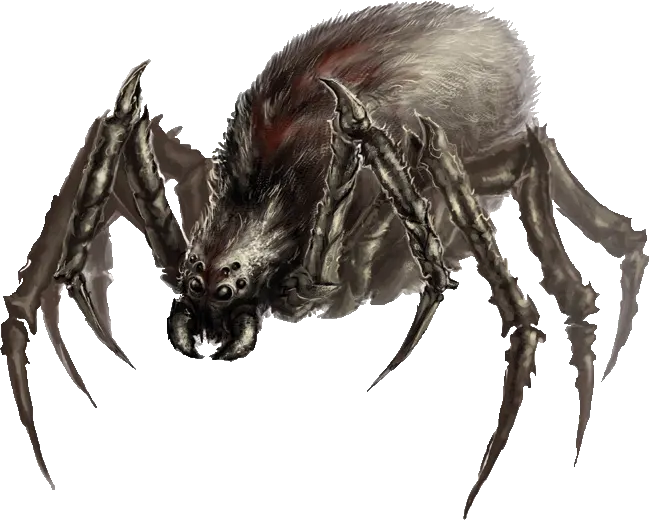“Of the cave spiders: these entirely disgusting creatures make their homes in caves. The cave spider is large and hairy, and the webs it spins for itself and its brood can trap creatures as large as an adult human, and those so ensnared cannot defend themselves. They can only watch as the spider draws closer and closer, waiting to drain them of blood and life. These unfortunates can only pray to the Twelve in Alveran that death comes quickly. Remember this: if you travel in the caves underground, torches not only illuminate the dark, they also set the webs of these spider creatures alight.”
— from a copy of the Bestiary of Belhanka
The cave spider’s body ranges from 55 to 63 inches long and is an imposing sight, even without its eight powerful, bristly legs, which gives most people who behold it a cold shiver. Males have black fur, while the females have brown fur that sometimes bears a reddish-brown mark. Dripping fangs complete this gruesome, nightmarish picture. Little is known about the origins of these giant arachnids. Some think they are result of a failed experiment from the Dark Ages, while others claim that they are the degenerate descendants of an alleged civilization of spiders. However, it is possible that they are simply very large spiders that aren’t supernatural at all.
Distribution
Cave spiders are relatively rare and live, as their name suggests, in caves, caverns, and mountain cracks, but some dwell in ruins and dark forests. One can easily recognize their territory by the presence of large cobwebs. However, since they constantly prowl around their vast territory when on the hunt, one might come across them quite unexpectedly. Their close relatives, the tree spiders, live in southern Aventuria. Unlike cave spiders, tree spiders do not spin webs. Rather, they stretch gluey snares between trees and rocks. The exceptionally rare mist spider, another relative, lives in the hot, humid mist forests of the South Sea island of Altoum, and is said to possess almost human intelligence, which it uses to devise traps and ambushes.
Finally, as another direct relative of the cave spider, there is the hook spider, which builds its nests in the Djurkaram Massif. Whoever ventures into the cave systems inside this mountain range in the middle of the Khôm Desert often gets surprised by the attacks of this spider, as its fur, coated with hooks, enables it to cling to the walls and ceilings of the caves and pounce down onto its prey with a jump. For some time there were also accounts, from rather unreliable sources, that there exist smaller specimens of cave spiders in the Svellt Valley who carry crystals on their bodies.
Way of Life
Finding a cave spider is easy. One need only tug on a web, even if it looks abandoned at first glance, because the spider hides out of sight at one of the corners of the web, waiting for prey. When waiting proves unsuccessful, these spiders go on the hunt. Some cave spiders are smart enough to stalk prey while waging an effective campaign of terror that causes victims to rush headlong in special webs prepared in advance. Anything caught by one of these strands, which is coated with an incredibly strong adhesive, finds it almost impossible to escape. The web’s substance is so robust that even stags and young aurochs have been caught in its embrace. Once victims are secured, the spider administers its bite. Contrary to popular belief, spider venom doesn’t kill victims, it only paralyzes, but this effect takes time. While waiting for the venom to take effect, the spider finishes cocooning its victim and hauls it up into its nest. Later, the spider injects the victim with slow acting digestive juices. The victim is then devoured alive at the spider’s convenience.
Cave spiders live alone or in large colonies, some of which have been occupied for generations. Spider colonies can pose a considerable threat even to experienced warriors. Spiders think in an alien fashion and appear to have no interest in valuables or man-made items of any kind. The possessions of all those who fall victim to these eightlegged creatures eventually get pushed to the side or wind up in nearby refuse piles.
Matings produce several dozen to several hundred eggs, which the mother hides close to the nest in a hollow tree or between small cracks in rocks. Hatchlings must fend for themselves, and few survive to adulthood. Of the various species, only the mother tree spider takes an active role in parenting, and the young spiderlings spend their days clinging to her body until they are old enough to survive on their own. Those that make it to old age remember those days as the happiest of their lives. In some species, the mother sacrifices herself to her young so that they can eat and grow. Maraskani and goblins regard cave spider eggs as a delicacy. Many a young goblin lad has found himself spun into a cocoon while attempting to prove his courage by stealing an egg.


